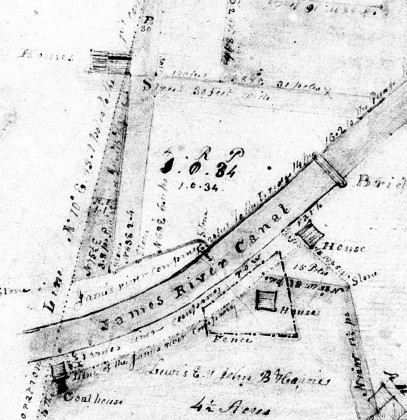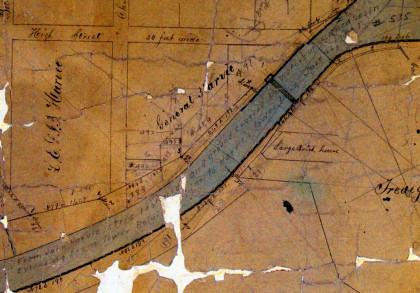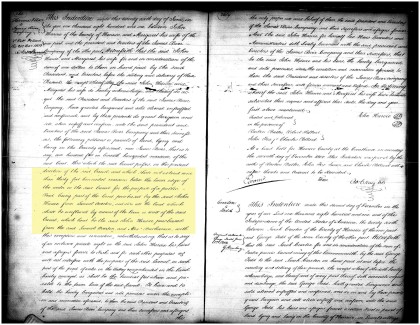New documentation from deed research that confirms that the 30 foot wide tow path on the site of Venture Richmond’s proposed amphitheater is authentic and dates from at least 1801.
As documented in Henrico Deed Book 6, page 260, when John Harvie and his wife on June 26, 1801 conveyed to the James River Company his property for the canal and for the upper basin, he reserved the right to fish in the basin and reserved the condition of a “public Road” on the lower side of the canal not more than 30 feet wide from the edge of the water. In this deed, the tow path embankment was referenced as a “Dam” for holding back the water that was to overflow the upper basin.
In this 1801 deed, Harvie and his wife conveyed to the James River Company, “… the following portions or parcels of land, lying and being in the County aforesaid, near James River, that is to say one hundred feet in breadth horizontal measure, of the said land, thro’ which the said Canal passes in the present direction of the said Canal, and which shall not extend more than thirty feet horizontal measure below the lower edge of the water in the said canal for the purpose of a public Road being part of the land purchased by the said John Harris from Samuel Overton, and also all the land which shall be overflowed by means of the Dam or wall of the said Canal …” (Please see attachment, “Henrico DB 6, page 260.”)
This 30 foot wide public access is clearly shown on the 1848 Plat of Harvie’s land. (Please see attachment, “Henrico Plat 3-417.”)
The 1868 Pleasants/Bates map, which shows the Canal company owning a 45 foot property width on the the south bank of the canal, has an inscription in the canal that references this June 26, 1801 Deed: “From John Harvie, strip 100′ wide and ground covered by water of upper basin … Extending from lower Belvidere line to Harvie’s lower line June 26, 1801” (Please see attachment, “1868 Pleasants/Bates map, detail showing 1801 Harvie deed reference.”)
As John Harvie recognized early on, by harnessing the water power available in the canal, there was great potential for industrial development on his land between the canal and the James River. He was a highly respected businessman, who not only was a Director of the James River Company and former Mayor of Richmond, but was one of the original statesmen in the Virginia delegation who ratified the U.S. Constitution. Harvie could command concessions in his sale of land to the James River Company that assured adequate access on the tow path for his industrial interests.
Hopefully, this new deed documentation will end the mistaken effort to alter the south bank of the canal from its authentic 1801 configuration for sight lines for the proposed amphitheater.



